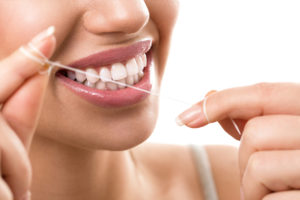 How often do you floss? According to a survey done in 2008 less than 50% of Americans floss daily and 10% report that they never floss. Another study found that over 70% of Americans would rather go to the grocery store than floss. We would like to dig a bit deeper into the issue of flossing and answer some questions you may have. We hope you learn something and enjoy!
How often do you floss? According to a survey done in 2008 less than 50% of Americans floss daily and 10% report that they never floss. Another study found that over 70% of Americans would rather go to the grocery store than floss. We would like to dig a bit deeper into the issue of flossing and answer some questions you may have. We hope you learn something and enjoy!
Why We Avoid Flossing
Many people report that they do not floss because they do not feel food trapped between their teeth and consequently do not feel the need. It is important to note that the mere presence of food between teeth is not the direct causative factor for tooth decay. Floss can clean plaque where a toothbrush cannot. This helps prevent the onset of decay.
Many others will claim that they do not know how to floss properly.
One more reason that people do not floss is the lack of proper dexterity to floss. Injuries, arthritis, and strokes can make it difficult to properly manipulate the floss. In addition, some teeth that are far back in the mouth are difficult to access. For these situations, there are many different products on the market (see picture on right) that allow for simple floss adaptation without the manual dexterity challenges.
Finally, many patients report that they do not floss because flossing creates pain. If you experience pain when you floss, chances are you could have gingivitis. Gingivitis is the beginning stages of gum disease.
It is often characterized by red swollen gums that can bleed when brushing or flossing. This indicates a problem and often this means flossing should be more frequent not less.
What Does Flossing Accomplish?
Essentially flossing is like brushing between your teeth. A toothbrush cannot adequately reach certain areas between the teeth. Proper flossing technique gently forces the floss between the teeth and cleans areas that are susceptible to decay. This is especially important when reaching those areas immediately below where adjacent teeth touch.
In addition, floss can reach further below the gum line than brushing alone. A recent study found that the average toothbrush can reach less than 1/5mm below the gum line while flossing can reach as far as 3mm.
Finally, tiny food particles that can become trapped below the gum line can trigger the body’s response and cause irritation. Floss can assist in removing these particles.
The Facts
If you read internet sources, you may find that there have been several articles written claiming that flossing is unnecessary. There has been much research done regarding the effects of flossing. Systematic studies done in 2006, 2008, and 2012 reported minimal reductions in plaque and gingivitis between flossing and non flossing populations. It is important to note that in all of these studies, the authors noted that proper technique was not utilized by the participants. We recommend you go to the American Dental Association link above and practice the recommended techniques.
One of the more interesting studies was performed in 2008 by the NYU College of Dentistry Periodontics department. They took 51 pairs of twins and had one twin floss and the other not floss and observed the results after 2 weeks. They found that the flossers had significantly reduced amounts of microbial species that cause periodontal disease and dental caries (more commonly known as cavities).
Does the Type of Floss Matter?
You can buy waxed, unwaxed, woven, shred resistant, and several other types of floss. The choices can be daunting. A study recently done at the University of Texas Science Center reported no significant differences between the major variants. All of the products reported a higher plaque reduction than brushing alone.
Ponte Vedra Complete Dentistry is dedicated to educating the public about oral health issues. If you would like to read more about a myriad of dental related issues, we encourage you to visit our past blog segments! We welcome comments and questions. Feel free to call us at (904)285-7711 or contact us online any time!



